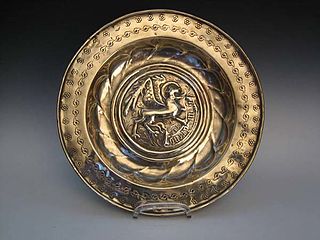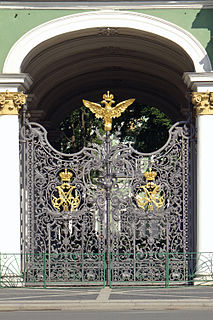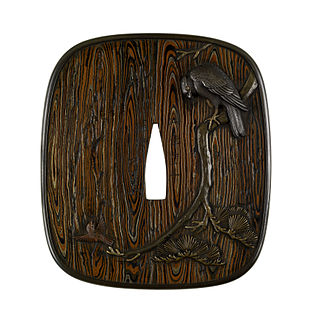 W
WIn modern usage, an aquamanile is a ewer or jug-type vessel in the form of one or more animal or human figures. It usually contained water for the washing of hands over a basin, which was part of both upper-class meals and the Christian Eucharist. Historically the term was sometimes used for any basin or ewer so used, regardless of shape. Most surviving examples are in metal, typically copper alloys, as pottery versions have rarely survived.
 W
WBeckenschlägerschüssel is a term used to refer to a specific group of brass bowls that emerged in the German-speaking world in the late 15th to 16th centuries.
 W
WChemical coloring of metals is the process of changing the color of metal surfaces with different chemical solutions.
 W
WA ciborium is a vessel, normally in metal. It was originally a particular shape of drinking cup in Ancient Greece and Rome, but the word later came to refer to a large covered cup designed to hold hosts for, and after, the Eucharist, thus the counterpart of the chalice.
 W
WA Coventry Cross of Nails is a Christian cross made from iron nails, employed as a symbol of peace and reconciliation. The original version was made from three large medieval nails salvaged from the Coventry Cathedral after the building was severely damaged by German bombs on 14 November 1940, during the Second World War. In the following decades, several hundred crosses have been given as gifts to various organisations, including churches, prisons and schools. The form of the cross echoes the crucifixion of Christ, and the nails with which Christ was affixed to the cross according to some accounts.
 W
WThe Ghisi Shield is a piece of Renaissance parade armour made by the Italian goldsmith and engraver Giorgio Ghisi, signed and dated 1554. It is part of the Waddesdon Bequest, held by the British Museum in London since 1898.
 W
WGuilloché is a decorative technique in which a very precise, intricate and repetitive pattern is mechanically engraved into an underlying material via engine turning, which uses a machine of the same name, also called a rose engine lathe. This mechanical technique improved on more time-consuming designs achieved by hand and allowed for greater delicacy, precision, and closeness of line, as well as greater speed.
 W
WThe Hereford Screen is a great choir screen designed by Sir George Gilbert Scott (1811–1878) and made by Coventry metalworking firm Skidmore & Co. for Hereford Cathedral, England in 1862. It was one of the Gothic Revival works in iron of the nineteenth century. When it was unveiled at the 1862 International Exhibition it was hailed as the "grandest and most triumphant achievement of modern architectural art". Weighing over eight tonnes, the screen is a mixture of wrought and cast iron, brass, copper, semi-precious stones, and mosaics, supporting electroformed statues of Christ and attendant angels. In 1967 the screen was dismantled as it was no longer considered fashionable. It was stored in wooden packing cases at Coventry's Museum store a waiting for it to be re-erected in a new museum dedicated to Coventry's Industrial past, but funds were never available,. So Coventry passed over the custodianship to the Victoria and Albert Museum in 1984, but it was in very poor condition. In 2001, after a successful campaign to fund the largest conservation project ever undertaken by the Museum, the fully restored metal masterpiece was erected in pride of place, overlooking the main entrance.
 W
WIronwork is any weapon, artwork, utensil or architectural feature made of iron especially used for decoration. There are two main types of ironwork: wrought iron and cast iron. While the use of iron dates as far back as 4000BC, it was the Hittites who first knew how to extract it and develop weapons. Use of iron was mainly utilitarian until the Middle Ages, it became widely used for decoration in the period between the 16th and 19th century.
 W
WJapanning is a type of finish that originated as a European imitation of Asian lacquerwork. It was first used on furniture, but was later much used on small items in metal. The word originated in the 17th century. American work, with the exception of the carriage and early automobile industries, is more often called toleware.
 W
WA lunette, or lunula, is an liturgical item used by in the Catholic Church for the exposition of the Host.
 W
WMetal corsets are a type of historical corset or bodice made entirely out of metal, usually iron or steel. The metal corset was popularly claimed to have been introduced to France by Catherine de' Medici in the 16th century, although this is now considered a myth. The idea that such garments were worn for fashionable purposes is debatable, with fashion historians now regarding such claims sceptically. Many of the original metal bodices that have survived are now believed to have been intended for medical purposes as orthopaedic support garments and back braces. Such garments were described by the French army surgeon Ambroise Paré in the sixteenth century as a remedy for the "crookednesse of the Bodie."
 W
WMississippian copper plates, or plaques, are plain and repousséd plates of beaten copper crafted by peoples of the various regional expressions of the Mississippian culture between 800 and 1600 CE. They have been found as artifacts in archaeological sites in the American Midwest and Southeast. The plates, found as far afield as Florida, Georgia, Illinois, Mississippi, Oklahoma, Tennessee, and Wisconsin, were instrumental in the development of the archaeological concept known as the Southeastern Ceremonial Complex. Some of the more notable examples are representations of raptorial birds and avian-themed dancing warriors.
 W
WMokume-gane (木目金) is a Japanese metalworking procedure which produces a mixed-metal laminate with distinctive layered patterns, as well as that laminate itself. Mokume-gane translates closely to "wood grain metal" or "wood eye metal" and describes the way metal takes on the appearance of natural wood grain. Mokume gane fuses several layers of differently coloured precious metals together to form a sandwich of alloys called a "billet." The billet is then manipulated in such a way that a pattern resembling wood grain emerges over its surface. Numerous ways of working the mokume gane create diverse patterns. Once the metal has been rolled into a sheet or bar, several techniques are used to produce a range of effects.
 W
WA monstrance, also known as an ostensorium, is a vessel used in Roman Catholic, Old Catholic, High Church Lutheran and Anglican churches for the more convenient exhibition of some object of piety, such as the consecrated Eucharistic host during Eucharistic adoration or Benediction of the Blessed Sacrament. It is also used as reliquary for the public display of relics of some saints. The word monstrance comes from the Latin word monstrare, while the word ostensorium came from the Latin word ostendere. Both terms, meaning "to show", are used for vessels intended for the exposition of the Blessed Sacrament, but ostensorium has only this meaning.
 W
WOpus interrasile, lit. 'work shaved or scraped in-between' is a pierced openwork metalworking technique found from the 3rd century AD, and remaining popular in Byzantine jewellery. It was developed and popularized in Rome, where metalworkers used it to make arabesques and other similar designs. The technique involves punching holes in metal to simulate lattice patterns, openwork gold jewelry, and so on. Patterns were often drawn on the metal, and then various tools used to remove the desired pieces.
 W
WOrmolu is the gilding technique of applying finely ground, high-carat gold–mercury amalgam to an object of bronze, and for objects finished in this way. The mercury is driven off in a kiln leaving behind a gold coating. The French refer to this technique as "bronze doré"; in English, it is known as "gilt bronze". Around 1830, legislation in France had outlawed the use of mercury for health reasons, though use continued to the 1900s.
 W
WThe pax was an object used in the Middle Ages and Renaissance for the Kiss of Peace in the Catholic Mass. Direct kissing among the celebrants and congregation was replaced by each in turn kissing the pax, which was carried around to those present. The form of the pax was variable but normally included a flat surface to be kissed. Often the pax was held out with a long handle attached, and it seems to have been given a wipe with a cloth between each person. Some paxes are very elaborate and expensive objects, and most survivals fall into this class, but the great majority were probably very simple wood or brass pieces. It was usual to include an image, usually of or including the Virgin Mary or Jesus Christ.
 W
WPilgrim badges are decorations worn by some of those who undertake a Christian pilgrimage to a place considered holy by the Church. They became very popular among Catholics in the later medieval period. Typically made of lead alloy, they were sold as souvenirs at sites of Christian pilgrimage and bear imagery relating to the saint venerated there. The production of pilgrim badges flourished in the Middle Ages in Europe, particularly in the 14th and 15th centuries, but declined after the Protestant Reformation of the mid-16th century. Tens of thousands have been found since the mid-19th century, predominantly in rivers. Together they form the largest corpus of medieval art objects to survive to us today.
 W
WRain chains are alternatives to a downspout. They are widely used in Japan. Their purpose is largely decorative, to make a water feature out of the transport of rainwater from the guttering downwards to a drain or to a storage container. They can also be found on temples.
 W
WSilver-gilt or gilded/gilt silver, sometimes known in American English by the French term vermeil, is silver which has been gilded with gold. Most large objects made in goldsmithing that appear to be gold are actually silver-gilt; for example most sporting trophies and many crown jewels are silver-gilt objects.